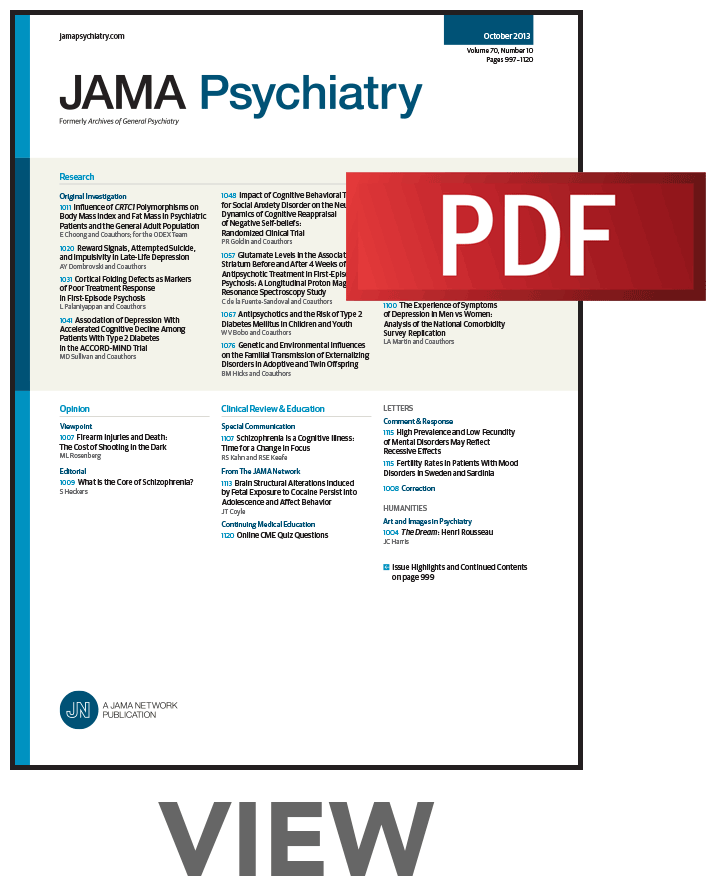Emergency Department Visits Involving Hallucinogen Use and Risk of Schizophrenia Spectrum Disorder
IF 22.5
1区 医学
Q1 PSYCHIATRY
引用次数: 0
Abstract
ImportanceInterest in and use of hallucinogens has been increasing rapidly. While a frequently raised concern is that hallucinogens may be associated with an increased risk of psychosis, there are limited data on this association.ObjectivesTo examine whether individuals with an emergency department (ED) visit involving hallucinogen use have an increased risk of developing a schizophrenia spectrum disorder (SSD).Design, Settings, and ParticipantsThis population-based, retrospective cohort study (January 2008 to December 2021) included all individuals aged 14 to 65 years in Ontario, Canada, with no history of psychosis (SSD or substance induced). Data were analyzed from May to August 2024.ExposureAn incident ED visit involving hallucinogen use.Main Outcomes and MeasuresDiagnosis of SSD using a medical record–validated algorithm. Associations between ED visits involving hallucinogens and SSD were estimated using cause-specific adjusted hazard models. Individuals with an incident ED visit involving hallucinogens were compared with members of the general population (primary analysis) or individuals with ED visits involving alcohol or cannabis (secondary analysis).ResultsThe study included 9 244 292 individuals (mean [SD] age, 40.4 [14.7] years; 50.2% female) without a history of psychosis, with a median follow-up of 5.1 years (IQR, 2.3-8.6 years); 5217 (0.1%) had an incident ED visit involving hallucinogen use. Annual rates of incident ED visits involving hallucinogens were stable between 2008 and 2012 and then increased by 86.4% between 2013 and 2021 (3.4 vs 6.4 per 100 000 individuals). Individuals with ED visits involving hallucinogens had a greater risk of being diagnosed with an SSD within 3 years compared with the general population (age- and sex-adjusted hazard ratio [HR], 21.32 [95% CI, 18.58-24.47]; absolute proportion with SSD at 3 years, 208 of 5217 with hallucinogen use [3.99%] vs 13 639 of 9 239 075 in the general population [0.15%]). After adjustment for comorbid substance use and mental health conditions, individuals with hallucinogen ED visits had a greater risk of SSD compared with the general population (HR, 3.53; 95% CI, 3.05-4.09). Emergency department visits involving hallucinogens were associated with an increased risk of SSD within 3 years compared with ED visits involving alcohol (HR, 4.66; 95% CI, 3.82-5.68) and cannabis (HR, 1.47; 95% CI, 1.21-1.80) in the fully adjusted model.Conclusions and RelevanceIn this cohort study, individuals with an ED visit involving hallucinogen use had a greater risk of developing an SSD compared with both the general population and with individuals with ED visits for other types of substances. These findings have important clinical and policy implications given the increasing use of hallucinogens and associated ED visits.使用致幻剂的急诊就诊与精神分裂症谱系障碍的风险
重要性人们对致幻剂的兴趣和使用在迅速增加。这项基于人群的回顾性队列研究(2008 年 1 月至 2021 年 12 月)纳入了加拿大安大略省所有年龄在 14 岁至 65 岁之间、无精神病史(SSD 或药物诱发)的人。主要结果和测量指标使用经过医疗记录验证的算法诊断出 SSD。使用病因特异性调整危险模型估算涉及致幻剂的急诊就诊与 SSD 之间的关系。研究纳入了 9 244 292 人(平均 [SD] 年龄为 40.4 [14.7] 岁;50.2% 为女性),均无精神病史,中位随访时间为 5.1 年(IQR,2.3-8.6 年);5217 人(0.1%)曾因使用致幻剂而在急诊就诊。2008年至2012年期间,使用致幻剂的急诊室就诊率保持稳定,2013年至2021年期间增加了86.4%(每10万人中有3.4人就诊,每10万人中有6.4人就诊)。与普通人群相比,使用致幻剂的 ED 患者在 3 年内被诊断为 SSD 的风险更高(经年龄和性别调整后的危险比 [HR],21.32 [95% CI,18.58-24.47];3 年后患 SSD 的绝对比例为:使用致幻剂的 5217 人中有 208 人 [3.99%] ,而普通人群为 9 239 075 人中有 13 639 人 [0.15%])。在对合并药物使用和精神健康状况进行调整后,与普通人群相比,使用致幻剂的急诊就诊者患 SSD 的风险更高(HR,3.53;95% CI,3.05-4.09)。在完全调整模型中,与使用酒精(HR,4.66;95% CI,3.82-5.68)和大麻(HR,1.47;95% CI,1.21-1.80)的急诊就诊相比,使用致幻剂的急诊就诊者在 3 年内罹患 SSD 的风险更高。在这项队列研究中,与普通人群和使用其他类型药物的急诊就诊者相比,使用致幻剂的急诊就诊者罹患 SSD 的风险更高。鉴于致幻剂的使用和相关的急诊就诊日益增多,这些发现对临床和政策具有重要意义。
本文章由计算机程序翻译,如有差异,请以英文原文为准。
求助全文
约1分钟内获得全文
求助全文
来源期刊

JAMA Psychiatry
PSYCHIATRY-
CiteScore
30.60
自引率
1.90%
发文量
233
期刊介绍:
JAMA Psychiatry is a global, peer-reviewed journal catering to clinicians, scholars, and research scientists in psychiatry, mental health, behavioral science, and related fields. The Archives of Neurology & Psychiatry originated in 1919, splitting into two journals in 1959: Archives of Neurology and Archives of General Psychiatry. In 2013, these evolved into JAMA Neurology and JAMA Psychiatry, respectively. JAMA Psychiatry is affiliated with the JAMA Network, a group of peer-reviewed medical and specialty publications.
 求助内容:
求助内容: 应助结果提醒方式:
应助结果提醒方式:


